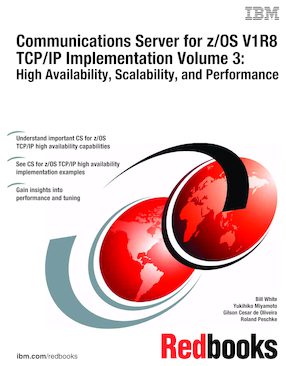Communications Server for z/OS V1R8 TCP/IP Implementation Volume 3: High Availability, Scalability, and Performance
An IBM Redbooks publication
Note: This is publication is now archived. For reference only.

Published on 19 January 2007
ISBN-10: 0738489840
ISBN-13: 9780738489841
IBM Form #: SG24-7341-00
Authors: Bill White, Yukihiko Miyamoto, Gilson Cesar de Oliveira and Roland Peschke
In this IBM Redbooks publication we begin with a discussion of Virtual IP Addressing (VIPA), a TCP/IP high-availability approach introduced by the z/OS Communications Server. We then proceed to show how VIPA can be used for high availability—both with and without using a dynamic routing protocol. Then we discuss a number of different workload balancing approaches that can be used with the z/OS Communications Server. In this book we use the terms internal and external application workload balancing to refer to approaches where the decision as to which application instance should received a given connection request is made within the sysplex environment (such as by Sysplex Distributor) or outside of it (using a separate, external, workload balancing solution), respectively. Finally, we explain the optimized Sysplex Distributor intra-sysplex load balancing. This function is an improved multi-tier application support using optimized local connections together with weight values from extended WLM interfaces.
For more specific information about CS for z/OS base functions, standard applications, and security, reference the other volumes in the series. These are:
Communications Server for z/OS V1R8 TCP/IP Implementation, Volume 1 - Base Functions, Connectivity, and Routing, SG24-7339
Communications Server for z/OS V1R8 TCP/IP Implementation, Volume 2 - Standard Applications, SG24-7340
Communications Server for z/OS V1R8 TCP/IP Implementation, Volume 4 - Policy-Based Network Security, SG24-7342
Chapter 1. Introduction
Chapter 2. Virtual IP Addressing
Chapter 3. VIPA without dynamic routing
Chapter 4. VIPA with dynamic routing
Chapter 5. Internal application workload balancing
Chapter 6. External application workload balancing
Chapter 7. Intra sysplex workload balancing
Chapter 8. Performance and tuning